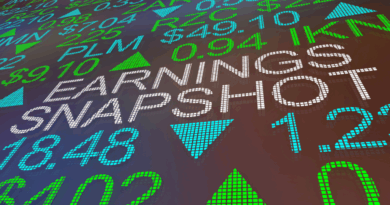Fed Uncertainty, Soft Inflation, and a 700% Winner
Producer Price Inflation comes in soft… how Jonathan Rose’s subscribers just made 700%… a huge step forward in the fintech space… how to test drive a seasonality trading tool
VIEW IN BROWSER
In news that’s sure to please President Trump, this morning’s Producer Price Index (PPI) showed wholesale prices were flat in June – below expectations for a 0.2% increase.
Core PPI, which excludes volatile food and energy components, also came in flat, missing the same 0.2% forecast.
Combined with yesterday’s tame Consumer Price Index (CPI) data, the takeaway is clear: For now, tariffs are not reigniting inflation.
That could still change. Many businesses stockpiled inventory ahead of key tariff deadlines… some are absorbing added costs and accepting slimmer margins… and price effects may simply take more time to show up.
Still, this creates a thornier situation for Federal Reserve Chairman Jerome Powell. Continued soft inflation gives critics more ammunition, making his “wait and see” stance on interest rates look increasingly difficult to defend.
All eyes now turn to July’s FOMC meeting two weeks from today. As we noted in yesterday’s Digest, an interest rate cut isn’t likely. But as pressure on Powell builds, we’ll be listening for new clues about the timing of the first cut.
Here’s the perspective of legendary investor Louis Navellier from this morning’s Growth Investor Flash Alert:
Now, because of all the inflation data we’ve had this week, the consensus is the Fed will not be cutting when they meet on July 29. But they’ll probably have a dovish FOMC statement and probably signal a September rate cut.
Obviously, President Trump wants rate cuts tomorrow mostly because the higher rates are hurting the housing market and other parts of our economy that are interest-rate sensitive.
So, he’s probably going to remain on his campaign about how horrible Jerome Powell is even though he appointed him.
Now, when Louis recorded his market update, he likely wasn’t aware of just how true his words would be…
Later this morning brought another twist in the Trump‑Powell saga – a possible firing of Powell.
Initial reports suggested that President Trump was “likely” to fire Fed Chair Powell. But shortly afterward, Trump shot it down, calling a firing “highly unlikely” unless fraud is involved.
For now, Powell’s job looks safe. Still, with Trump remaining highly critical of Powell’s interest rate policies, this drama appears far from over.
We’ll report back.
Some of our InvestorPlace subscribers just made about 700% returns in just over two weeks
I want to show you how, then put a copycat trade on your radar that’s live today.
Just over two weeks ago, veteran trader Jonathan Rose sent his Advanced Notice subscribers a trade recommendation:
We’re seeing a lot of bullish UOA in [this particular stock] hit the tape in the wake of the recent sell-off, closing below the weekly expected move.
Let’s jump on the $37 strike calls and get in position to capitalize on the rebound.
To make sure we’re all on the same page, “UOA” stands for Unusual Options Activity – that’s the heart of Jonathan’s trading approach in his trading service Advanced Notice.
If you’re new to the Digest, Jonathan cut his teeth on the floor of the Chicago Board Options Exchange, squaring off against some of the most aggressive traders in the world. During that time, he learned a trading axiom that’s helped him pull millions of dollars out of the market with his own trading…
If you want to know where the market’s headed, follow the smart money.
To do this, Jonathan built a scanner to detect unusually large options trades – often the footprints of institutional players placing high-conviction bets.
Time and again, these trades have foreshadowed major price moves before they hit the mainstream radar. For traders who see them, and position themselves accordingly, it can result in fast triple-digit trading returns.
And that brings us to about two weeks ago…
On Monday 6/30, Jonathan sent out a trade alert after his scanner picked up MP Materials (MP)
If MP sounds familiar, it’s because Louis Navellier gave it away as a free bonus pick during his recent live broadcast.
Louis was urging investors to get into leading rare earth elements (REE) stocks as the U.S./China AI war heats up.
Last Thursday – the week after Jonathan’s trade alert – the Pentagon announced a $400 million investment into MP Materials, instantly positioning the company as a strategic national security play. It sent the stock soaring 51% on Thursday, and Jonathan’s subscribers deep into the green.
Let’s rewind to last Thursday’s Digest:
This morning, subscribers to Jonathan Rose’s Advanced Notice service, who followed his advice, banked about 534% on one of their MP Materials call options…
If you’re lucky enough to score a 500%+ return in about a week, many investors would find it near impossible not to take all their chips off the table. And for good reason…
- A new headline could reverse the recent gains…
- The risk of a sharp pullback is high given other lucky traders who mighty choose to take their profits…
- Options are volatile and could lose value for all sorts of reasons…
- Timeworn trading wisdom urges investors not to get too greedy.
On the other hand, “fortune favors the bold” …
Jonathan’s subscribers navigated this tension by locking in some of their 534% profits by selling – yet holding a remaining portion of the trade open just in case lightning struck twice.
Turns out, this was the right call.
Let’s go to yesterday’s trade alert from Jonathan:
The hits keep on coming for MP…
[Yesterday] morning tech giant Apple announced it will one-up the DoD with a $500 million investment of its own. The news caused shares of MP to jump another 10%, above the $54 mark.
With shares trading at record highs, and nearly maxing out our call spread, it’s time to head for the exits.
The official return on this tranche of Jonathan’s trade clocked in at 700%. A huge “congratulations” to all the Advanced Notice subscribers.
This is a great illustration of the power of following the big money in the options market.
A new REE trade that has copycat potential
Yesterday, Jonathan sent a new All-Access Bonus Trade Alert to his Masters in Trading All Access subscribers.
He was kind enough to let me share the name with our broad Digest file. But let me clarify: if you decide to trade this stock, be smart – don’t overextend yourself.
Jonathan is recommending that his subscribers place a specific, risk-defined trade. And that’s the hallmark of pro traders: risk mitigation.
With that said, here’s Jonathan:
NioCorp Developments Ltd. ($NB) is another rare earth minerals company sitting at the heart of something big.
They’re advancing a critical minerals project in Nebraska — just like we’ve seen with MP and TMC, demand for them is spiking in defense, energy, and the AI boom.
The U.S. wants to secure supply onshore, and that puts companies like NioCorp in the spotlight.
If you’re looking for what could be the market’s next major overnight winner, consider yourself in the loop. We’ll circle back on how this plays out.
To learn more about how Jonathan capitalizes on these institutional money flows in Advanced Notice, click here.
Continuing with “trading,” let’s profile our next “trading series” installment
Over the past month, we’ve spotlighted several different trading strategies – each offering a unique edge in today’s volatile markets.
We’re doing this series because trading is no longer optional for the modern investor. In a year marked by outsized market swings, having tactical tools like trading in your arsenal can be the difference between outperforming and lagging.
Today, let’s zoom out and take a 30,000-foot view of a new strategy: pattern trading – specifically, seasonal trading.
To make sure we’re all on the same page, seasonal trading relies on calendar-based patterns that tend to repeat. These trends emerge across asset classes and indexes, giving traders a potential edge when timed correctly.
One of the most well-known examples is “Sell in May and go away” (so far, not a great idea this year).
But while some broad seasonal trends have worked well historically, they pale in comparison to what data and technology are now enabling.
Given advancements in technology, investors have a whole new world of seasonal trading opportunities
Today, we have the computing power to detect repeatable patterns not just across indexes – but down to individual stocks.
To explore this further, let’s bring in Keith Kaplan, CEO of our corporate partner TradeSmith, one of the most advanced quantitative investing firms in the world.
Keith and his team of quants have created a seasonality trading tool that identifies the exact days to buy and sell a stock based on its unique, historical patterns. It’s a huge step forward in the fintech space.
Here’s Keith:
Our algorithm runs 50,000 tests a day to analyze every stock in the major indexes and zero in on the ones with the strongest seasonality trends…
Some stocks trade so consistently—rising or falling during specific windows, year after year—that you can map out a year’s worth of great trades.
Turns out stocks have their own “seasons” to rise or fall. A kind of summer… and a kind of winter, too. Repeating year after year.
And those seasons provide a powerful edge over most investors.
For example, let’s look at Amazon (AMZN).
TradeSmith’s Seasonality tool shows that every year over the last 15 years, Amazon stock has risen from May 24 through July 13 with an average return of +10.2%.
And this year, that pattern not only held, but did even better. If you traded the same window in 2025, Amazon delivered an even stronger return: +11.9%.
Another example comes from Hasbro (HAS).
TradeSmith’s data identified the best window to own it as April 14–27.
The stock has averaged a +6.7% return during this stretch. Here in 2025, despite market turbulence, it climbed more than 13% in that exact timeframe.

I’ll add that the tool works on specific stocks, indexes, even currencies and commodities.
This style of trading is effective for investors who want to outsource their markets decisions to data and algorithms
If you tend to second-guess your trades – or if you’d rather rely on historical data and machine-calculated logic – this strategy might be a good fit.
It’s also ideal for those who prefer shorter holding periods, ranging from just a few days to a couple of weeks.
For example, Keith provided a list of recent triple-digit winners from the seasonality tool with hold-periods ranging from 14 days to 23 days.
The best way to determine whether this tool fits your trading needs is to give it a test drive
That way, you can get a sense for what it can do, and how it might complement your own trading approach.
Next Tuesday, July 22 at 10 a.m., Keith is holding a webinar to walk through all the features of seasonality tool. When you register to join (by clicking here), you’ll get free access to it.
So, we invite you to try it out for yourself and then decide whether it’s a good fit.
Back to Keith:
This isn’t about trying to predict the future… or pretending we can guarantee returns.
It’s about discovering patterns that tilt the odds in your favor—then acting on them with the kind of cold, calculated logic…
Bottom line: If you’re looking to add analytical firepower to your trading, this is a platform worth exploring.
What the seasonality predicts is coming for the broad market
Later this week, we’ll dive into what the seasonality tool predicts is on the way for the stock market as we approach the fall.
In short, there’s volatility on the horizon with implications for how to position your portfolio. More details to come…
For now, click here to reserve your spot for the webinar with Keith, then start playing around with the seasonality tool.
Have a good evening,
Jeff Remsburg
The post Fed Uncertainty, Soft Inflation, and a 700% Winner appeared first on InvestorPlace.






